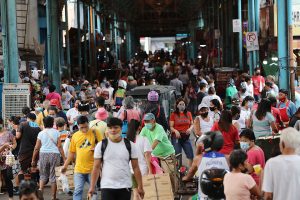Philippines still at low risk from COVID, says DoH

THE PHILIPPINES remains at low risk from the coronavirus despite rising infections, health authorities said on Tuesday.
The average daily attack rate was 3.42 cases per 100,000 population, with national and all regions showing increased infections, Health officer-in-charge Maria Rosario S. Vergeire told a virtual news briefing Filipino.
“The National Capital Region (NCR) and Cordillera Administrative Region (CAR) are at a moderate risk case classification, with an average daily attack rate of 9.15 for NCR and 7.29 for CAR,” she added. Other areas remained at low-risk.
The use of intensive care units (ICU) in the country has steadily increased since the start of July, Ms. Vergeire said. There were 772 severe and critical admissions or 19.3% of the total, almost as high as the level in March.
ICU use in the Bangsamoro region was at moderate risk, while four other regions— Calabarzon, Western Visayas, Zamboanga Peninsula and Davao — were near the threshold at more than 40%.
“The national weekly positivity rate has risen to 18.6% from 16.7% last week,” Ms. Vergeire said.
The Department of Health (DoH) also reported 906 more infections involving the Omicron subvariant BA.5, with 814 patients have recovered and 49 still in isolation. This brought the total to 4,013 cases.
Eleven more patients have been infected with the BA.4 subvariant, all of whom have recovered. This brought the total to 115 cases.
There were also seven more BA.2.12.1 patients, bringing the total to 181. All of them have recovered, DoH said.
Ms. Vergeire reiterated projections that the coronavirus infections in the capital region could hit 11,000 by the end of August.
Cases are expected to rise for the rest of the year if booster uptake remained low, people don’t comply with health standards and are allowed to move more freely, and more Omicron subvariants enter the country.
“These projections may happen, but hopefully not because we have control over two of these assumptions and that would be the uptake of boosters and the compliance to public health standards,” she said.
“I am calling for our people to help each other so that we do not reach this increase in cases in our country,” Ms. Vergeire said. “Let us get vaccinated and continue to comply with minimum public health standards.”
Almost 72 million Filipinos had been fully vaccinated against the coronavirus as of Aug. 8. More than 9.7 million adolescents, more than 4.2 million children and almost 6.8 million seniors have received their first dose, the agency said. More than 16.6 million people have received their first booster and 1.5 million their second booster.
“These vaccines are safe, effective and freely given by our government,” Ms. Vergeire said, urging people to get vaccinated to protect themselves from the virus. — Alyssa Nicole O. Tan




